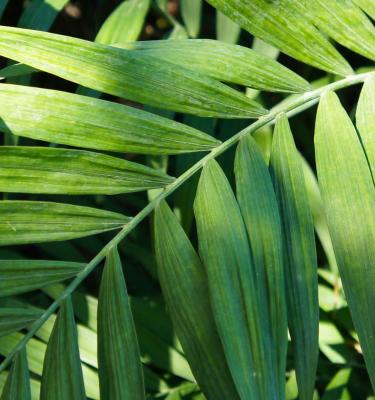

How to grow & care for Parlor palms
Parlour Palms (Chamaedorea elegans) bring a tropical vibe to any home without the need for a tropical climate. They prefer temperatures around 18-24°C and a bright, indirect light spot. They’ll be happiest in a room with average humidity, but they’ll also tolerate a drier climate.
They also thrive on a moderate amount of neglect, so Parlour Palms are great for beginner gardeners and as they are very slow growing, so they won’t need regular repotting. Parlour Palms grow in clumps that can be divided to create more plants - this is best done when your current Parlour Palm clump fills the pot and you’re ready to repot it.
If you’re looking for an indoor plant with height, then the Parlour Palm is ideal - indoors, as a potted plant they can grow up to 1.5 metres tall.
Top 5 steps to growing a Parlour Palm
- A Parlour Palm prefers a spot with low to bright indirect light - direct afternoon sun can burn their leaves.
- Use a premium, like Scotts Osmocote Premium Potting Mix for Indoor Plants to give your plant the best start possible
- Parlour Palms like a moist, but free draining soil. Make sure the pot has drainage holes and don’t allow water to collect in saucers or the base of cover pots.
- Fertilise Parlour Palms with an indoor plant fertiliser like Scotts Osmocote Pour+Feed for Indoor Plants once a month during spring and summer, to encourage strong healthy growth.
- Parlour Palms will tolerate a low humidity spot, but they will prefer to be away from the drying drafts of heaters or air conditioners.
Shopping List
- A Parlour Palm
- A suitable pot
- Scotts Osmocote Premium Indoor Potting Mix
- Scotts Osmocote Controlled Release Fertiliser for Indoor Plants or Scotts Osmocote Pour+Feed for Indoor Plants
- A potting mix scoop or garden trowel
- Defender Pyrethrum Insect Spray
Growing in a pot
Choose a pot for your Parlour Palm that’s roughly 2 times the size of the original nursery pot - make sure it has drainage holes or use a black plastic pot that sits snugly inside a cover-pot or cache pot (pot with no holes).
Half fill your pot with Scotts Osmocote Premium Indoor Potting Mix and gently remove the Parlour Palm from the nursery pot and position it into the potting mix, backfill around root ball with more potting mix so that the potting mix is level with, or slightly below, the top of the pot.
Water your new Parlour Palm in well and tip out any excess water from the base of the cover-pot or saucer (if using). Parlour Palms prefer a moist soil that is never soggy and they are ready to be watered once the top 2-3cm of potting mix is dry to the touch. Never let water pool in the base of cover-pots or in saucers as your Parlour Palm will quickly rot if their potting mix remains soggy or waterlogged.
Fertilising & Care
Fertilise Parlour Palms fortnightly in spring and summer with an indoor plant fertiliser to encourage new growth. Use Scotts Osmocote Pour+Feed for Indoor Plants - this is a simple to use ‘measure and pour’ feed which contains the right balance of nutrients. If you’d prefer a longer term fertilising product, with less applications, apply Scotts Osmocote Controlled Release Fertiliser for Indoor Plants in early spring and again in early autumn - this product feeds for up to 6 months.
In the warmer months of spring and summer Parlour Palms will appreciate a more regular watering and a higher humidity. To increase the humidity around Parlour Palms, group them with other plants to create a microclimate. You can also sit their pot on a saucer filled with pebbles and water - as the water evaporates it will humidify the air.
Remove any dead or damaged fronds at the base to promote new growth. To remove the dust that collects on Parlour Palm leaves, pop it into the shower or bring it outside for a gentle hose off or use a soft, damp cloth to remove stubborn dust gently.
Pests & Diseases
Parlour Palms are most susceptible to scale, mites and mealybugs - regularly check at the base of fronds and the backs of the leaves for signs of these pests - use Defender Pyrethrum Insect Spray to control them if needed.
Yellowing leaves on your Parlour Palm could indicate excess or under watering - only water when the top 2-3cm of potting mix or soil feel dry.
Browning leaves on a Parlour Palm could be a sign of not enough water, too much water or too much direct sunlight. Adjust your watering and increase watering if the soil feels dry or relocate your Parlour Palm to a more shaded position.



